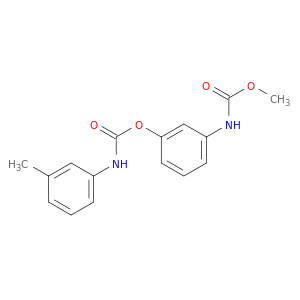
[3-(methoxycarbonylamino)phenyl] N-(3-methylphenyl)carbamate
| Title | Journal |
|---|---|
| Acute and chronic toxicity of Betanal(®)Expert and its active ingredients on nontarget aquatic organisms from different trophic levels. | Environmental toxicology 20120901 |
| Differential gene expression analysis in Enchytraeus albidus exposed to natural and chemical stressors at different exposure periods. | Ecotoxicology (London, England) 20120101 |
| Enchytraeus albidus microarray: enrichment, design, annotation and database (EnchyBASE). | PloS one 20120101 |
| Development of a microarray for Enchytraeus albidus (Oligochaeta): preliminary tool with diverse applications. | Environmental toxicology and chemistry 20110601 |
| Biochemical characterization of cholinesterases in Enchytraeus albidus and assessment of in vivo and in vitro effects of different soil properties, copper and phenmedipham. | Ecotoxicology (London, England) 20110101 |
| Can avoidance in Enchytraeus albidus be used as a screening parameter for pesticides testing? | Chemosphere 20100301 |
| Purification and characterization of organic solvent and detergent tolerant lipase from thermotolerant Bacillus sp. RN2. | International journal of molecular sciences 20100101 |
| Mining biologically-active molecules for inhibitors of fatty acid amide hydrolase (FAAH): identification of phenmedipham and amperozide as FAAH inhibitors. | Bioorganic & medicinal chemistry letters 20091201 |
| Effects of natural and chemical stressors on Enchytraeus albidus: can oxidative stress parameters be used as fast screening tools for the assessment of different stress impacts in soils? | Environment international 20090201 |
| Avoidance test with Enchytraeus albidus (Enchytraeidae): effects of different exposure time and soil properties. | Environmental pollution (Barking, Essex : 1987) 20080901 |
| 2-Acetyl-hydrazono-2-phenyl-aceto-hydrazide. | Acta crystallographica. Section E, Structure reports online 20080901 |
| Analysis of carbamate pesticides in water samples using single-drop microextraction and gas chromatography-mass spectrometry. | Analytical and bioanalytical chemistry 20080601 |
| Enchytraeus albidus (Enchytraeidae): a test organism in a standardised avoidance test? Effects of different chemical substances. | Environment international 20080401 |
| Modification and re-validation of the ethyl acetate-based multi-residue method for pesticides in produce. | Analytical and bioanalytical chemistry 20071101 |
| Selected stormwater priority pollutants: a European perspective. | The Science of the total environment 20070920 |
| Monitoring the efficacy and metabolism of phenylcarbamates in sugar beet and black nightshade by chlorophyll fluorescence parameters. | Pest management science 20070601 |
| Comparison of different sorbents for multiresidue solid-phase extraction of 16 pesticides from groundwater coupled with high-performance liquid chromatography. | Talanta 20070115 |
| Drift of 10 herbicides after tractor spray application. 1. Secondary drift (evaporation). | Chemosphere 20060701 |
| Fate of the herbicides glyphosate, glufosinate-ammonium, phenmedipham, ethofumesate and metamitron in two Finnish arable soils. | Pest management science 20060601 |
| Use of growth regulator of cytokinin type for enhancement and modification of herbicide activity. | Communications in agricultural and applied biological sciences 20060101 |
| Effect of different soil types on the enchytraeids Enchytraeus albidus and Enchytraeus luxuriosus using the herbicide Phenmedipham. | Chemosphere 20051201 |
| [Analysis of phenmedipham in agricultural products by HPLC]. | Shokuhin eiseigaku zasshi. Journal of the Food Hygienic Society of Japan 20051201 |
| Effects of different soil types on the Collembolans Folsomia candida and Hypogastrura assimilis using the herbicide Phenmedipham. | Archives of environmental contamination and toxicology 20051001 |
| Avoidance behaviour of Enchytraeus albidus: effects of benomyl, carbendazim, phenmedipham and different soil types. | Chemosphere 20050401 |
| Effect of tank mixed adjuvants on the drift potential of phenmedipham formulations. | Communications in agricultural and applied biological sciences 20050101 |
| Adsorption of sugar beet herbicides to Finnish soils. | Chemosphere 20040401 |
| Evaluation of herbicide combinations for livid amaranth (Amaranthus blitum) control in tuberous begonia (Begonia x tuberhybrida). | Communications in agricultural and applied biological sciences 20040101 |
| The influence of lipophilicity and formulation on the distribution of pesticides in laboratory-scale sediment/water systems. | Pest management science 20030201 |
| Ethoxylated rapeseed oil derivatives as novel adjuvants for herbicides. | Pest management science 20021201 |
| Biological monitoring of phenmedipham: determination of m-toluidine in urine. | Archives of toxicology 20010501 |
| Liquid chromatographic/mass spectrometric determination of desmedipham and phenmedipham and their metabolites in soil. | Journal of AOAC International 20010101 |